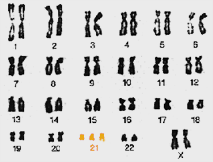Down syndrome (DS) is the most common form of intellectual disability with an incidence
rate of about 1 in 700 births and a prevalence of more than 400,000 in the U.S.
and just under 6 million worldwide. It is a genetic condition also called Trisomy
21 because people with DS have 3 copies of chromosome 21 rather than 2. People
with DS share characteristic physical features and have a higher risk for congenital
heart defects, gastroesophageal reflux disease, recurrent ear infections, obstructive
sleep apnea, thyroid dysfunctions, and impaired vision and hearing.
Children with DS display a decline in IQ starting in the first year
of life and trail cognitive development of their peer group throughout childhood.
By adulthood, people with DS have IQs in the mild to moderately delayed (35–80)
range. Impaired short term and long term memory which may result from hippocampal-mediated
dysfunction is a hallmark for this population. Pronounced speech and language deficits
are common and thought to be driven by significant deficits in verbal short term
memory.

Trisomy 21 may drive over-inhibition of the brain in DS leading to cognitive disability.
Though improvements in the treatment and management of physical complications have
extended the projected life span of persons with DS from 12 years in 1949 to 60
years and beyond today (median of 49), there have been very few research and development
efforts to address the cognitive disability in this population. Accordingly, this
has been and remains a neglected and much underserved area of drug development.
There are currently no pharmacological options to address the cognitive deficits
in DS.
Today most people with DS require supervision and assistance from family or public
agencies their entire lives. It is likely that even 10-20% improvements in cognition
would have major benefits in learning, language and executive function and enable
persons with DS to live more independently and to be more fully integrated in their
communities. Furthermore, enhanced cognition could reduce the cost of care and burden
to society, and significantly improve the quality of life for both people with DS
and their families.